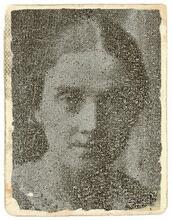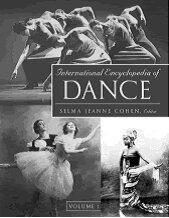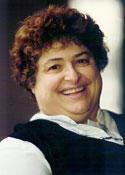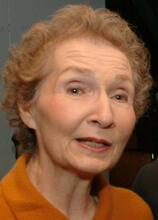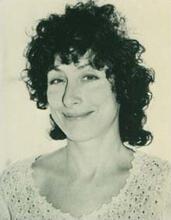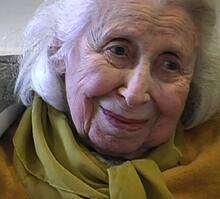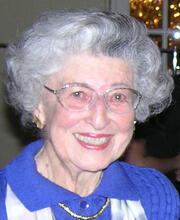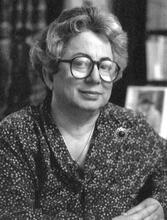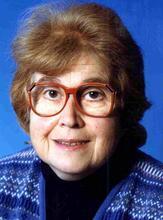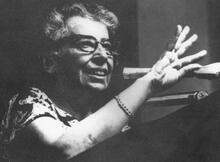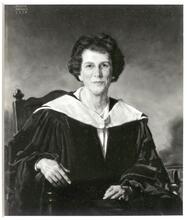Esther Rosenthal-Shneiderman
Esther Rosenthal-Shneiderman was born in Poland in 1902 and died in Jerusalem in 1989. In the early 1930s she emerged as an editor of children’s periodicals—Yunger shloger (Young Shock Worker, 1931), and Oktyaberl (Child of the October Revolution, 1932)—and an author or co-author of several textbooks for Soviet Yiddish schools. In 1934, she moved to Birobidzhan. IIn 1962 Esther and her husband settled in Israel where she took an active part in postmortem examination of Soviet Yiddish cultural history. Rosenthal-Shneiderman’s books concentrate on the personalities and events of Ukraine and Birobidzhan. She often appears only as the narrator rather than a protagonist in the tragic story, which began with the unprecedented, state-sponsored Yiddish culture construction of Birobidzhan and ended with its almost total liquidation.
Personal Life and Family
The Soviet Period: Birobidzhan
During the Soviet period of her life, Rosenthal-Shneiderman combined academic, pedagogical, and political activities. She was the head of the communist party organization at the IJPC, a graduate student and later a research fellow at its Pedagogical Section, and a lecturer at the Kiev Teachers Training Institute. In the early 1930s she emerged as an editor of children’s periodicals—Yunger shloger (Young Shock Worker, 1931) and Oktyaberl (Child of the October Revolution, 1932)—and an author or co-author of several textbooks for Soviet Yiddish schools. After returning to Poland in 1958, she wrote textbooks for local Yiddish schools. During the mass purges of the late 1930s she and her husband miraculously escaped being sent to labor camps. Nonetheless, Liberberg’s arrest and execution in 1936, together with Stalinist repressions of Yiddish cultural activists before and after World War II, caused the radical ideological transformation of Rosenthal-Shneiderman: the communist firebrand became a bitter critic of the Soviet regime and its nationalities policy.
Yiddish Literary Contributions in Israel
In Israel Rosenthal-Shneiderman took an active part in postmortem examination of Soviet Yiddish cultural history. The three volumes of her books Oyf vegn un umvegn (On Main and Circuitous Roads, 1974, 1978, 1982; published in Hebrew in 1978–1989 as Naftule derakhim) and Birobidzhan fun der noent (Birobidzhan from Close Up, 1983, in Hebrew: Birobidz’an mi-karov, 1990) intertwine personal memoirs with the results of her research work at the Hebrew University’s Center for Research and Documentation of East European Jewry. Together with similar memoirs published in Israel in the 1970s and 1980s—most notably Vu bistu, khaver Sidorov? (Where are You, Comrade Sidorov?, 1975), Fun ineveynik (From Inside, 1978) and Oyf der letster pozitsye mit der letster hofenung (At The Last Position with the Last Hope, 1982) by the Polish and Soviet Jewish communist functionary Hersh Smolar—they provide panoramic, insightful portrayals of Soviet Yiddish academic and cultural circles.
Soviet Yiddish Literary Legacy
Rosenthal-Shneiderman’s books concentrate on personalities and events in Ukraine and Birobidzhan. She often appears only as the narrator or even a detached observer rather than a protagonist in the tragic story, which began with the unprecedented, state-sponsored Yiddish culture construction and ended with its almost total liquidation. For instance, Rosenthal-Shneiderman describes Liberberg’s rise to the top academic position on the Soviet Yiddish Olympus, his wars of attrition with Jewish functionaries in Moscow and Minsk, his 1928 attempt to organize a visit of the émigré Jewish historian Simon Dubnow (1860–1941), and his other steps to expand the IJPC into the most significant center for Yiddish scholarship. In the early 1930s, he tried to move this center to Birobidzhan. Some of the invited literati even entertained the notion that the Birobidzhan population would in the not-too-distant future speak a uniform Yiddish language rather than pristine dialects. Moreover, such people as Rosenthal-Shneiderman regarded themselves as pioneers of the first Jewish state which, they believed, would ultimately grow into a populous, highly-developed Soviet republic—the spiritual center for all Jewish proletarians and a convincing alternative to the Zionist project.
Rosenthal-Shneiderman’s reckoning with history is not necessarily objective. The ambitious functionary Liberberg, for instance, appears in her books as an embodiment of the communist ideals of her youth, the antithesis of the party boss of Birobidzhan, Matvei Khavkin, whom she stereotyped as an upstart primitive bureaucrat. For all that, her documented memoirs constitute an important source for students of Soviet Jewish life. Inter alia, Rosenthal-Shneiderman’s writings contain unique portraits of such personalities as the historians of Yiddish literature Meir Wiener and Max Erik, the proletarian writer and critic Abraham Abchuk, and the linguists Nokhum Shtif and Elie Spivak.
Estraikh, Gennady. “Rozental-Shnayderman, Ester.” YIVO Encyclopedia of Jews in Eastern Europe (2010). https://yivoencyclopedia.org/article.aspx/Rozental-Shnayderman_Ester.
Hirsh Osherovitsh, ed. Yidish literatur in Medines-Yisroel, vol. 2, pp. 356–370. Tel Aviv, 1991.
Sfard, David. Mit zikh un mit andere. Jerusalem, 1984.

